The Daily Shot: 04-Oct-22
• The United States
• Canada
• The United Kingdom
• The Eurozone
• Europe
• Japan
• Asia – Pacific
• Emerging Markets
• Cryptocurrency
• Commodities
• Energy
• Equities
• Credit
• Rates
• Global Developments
• Food for Thought
The United States
1. The ISM manufacturing PMI showed stalling growth in US factory activity.
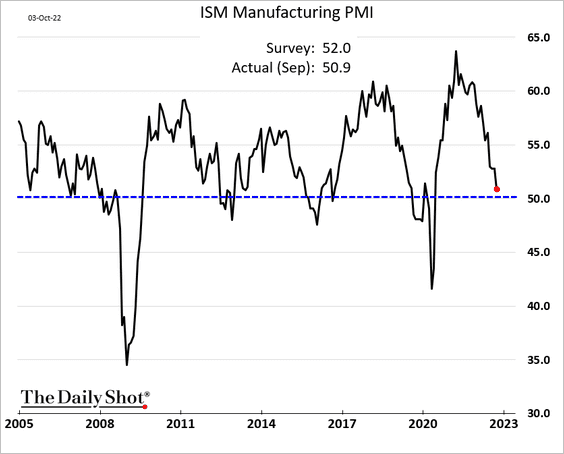
Orders and employment are now a drag on the PMI index.
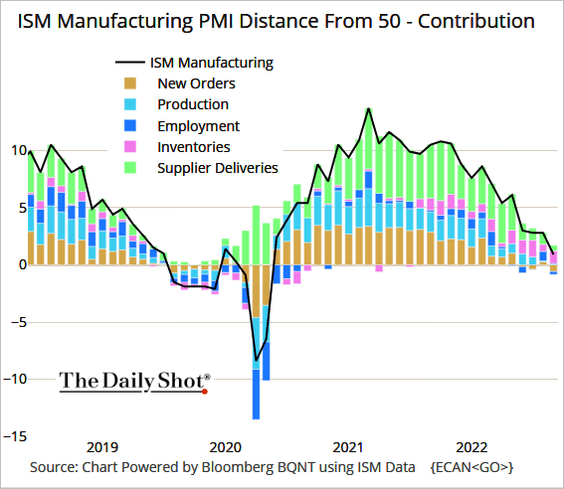 Source: @TheTerminal, Bloomberg Finance L.P.
Source: @TheTerminal, Bloomberg Finance L.P.
• New orders are shrinking (2 charts).
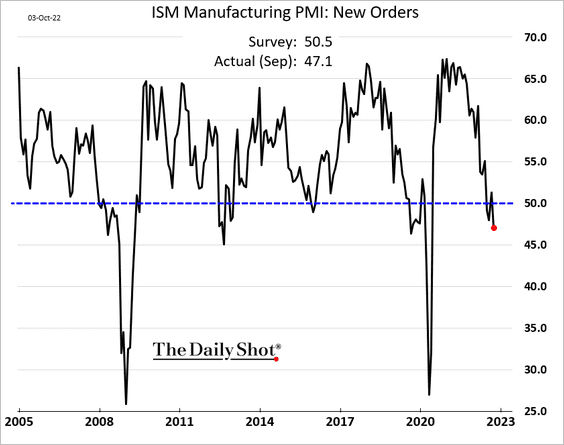
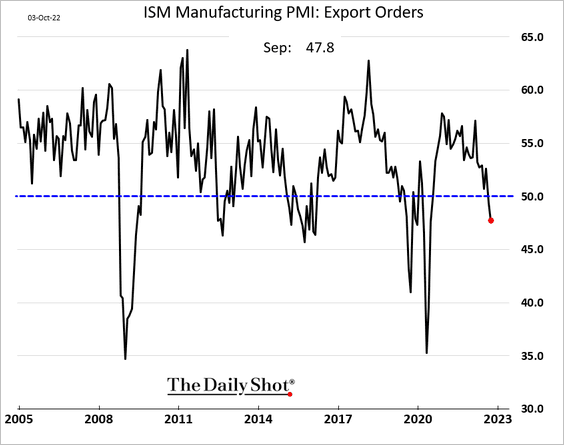
• Hiring has stopped.
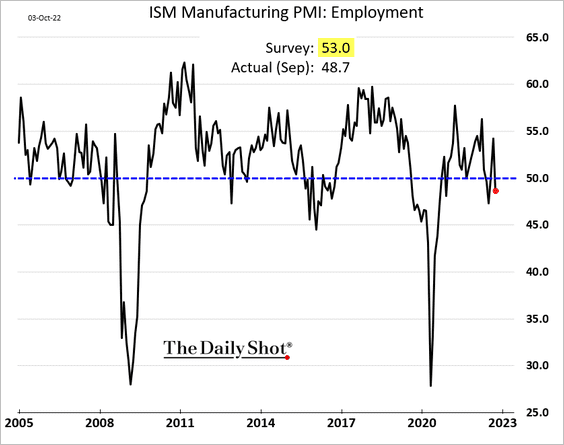
• The backlog of orders is not growing.
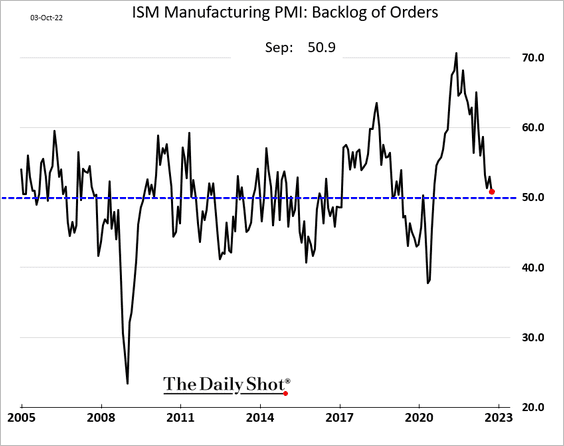
• Customer inventories are rebounding.
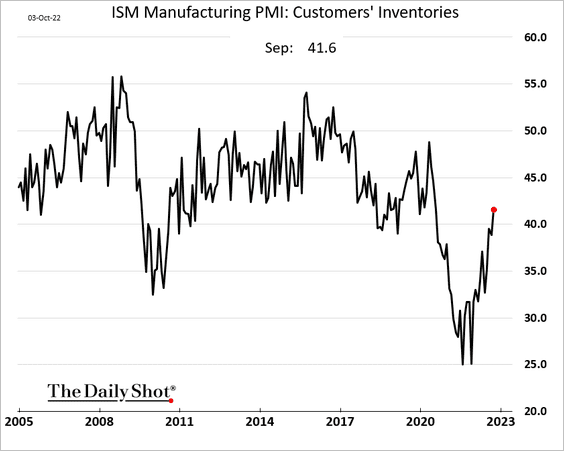
• Supply pressures continue to ease.
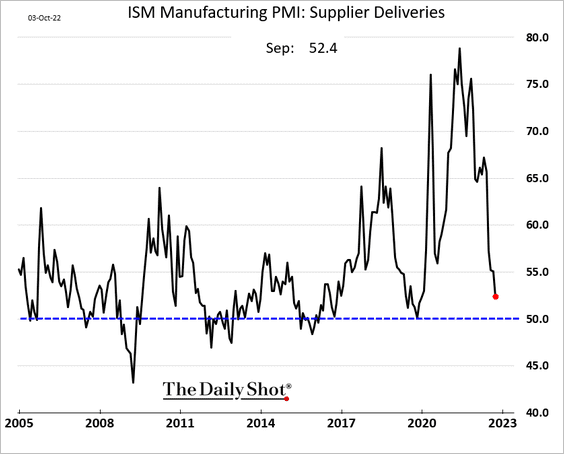
• Input price gains keep slowing, …
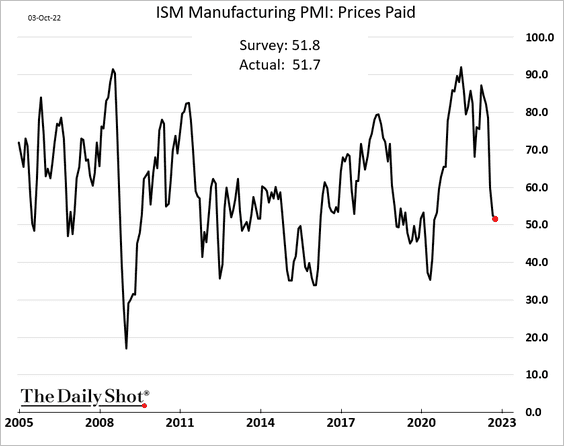
… which points to moderating inflation.
– The headline CPI vs. the ISM input price index:
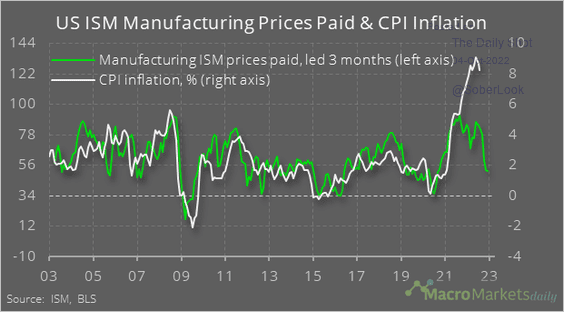 Source: @macro_daily
Source: @macro_daily
– Goods CPI:
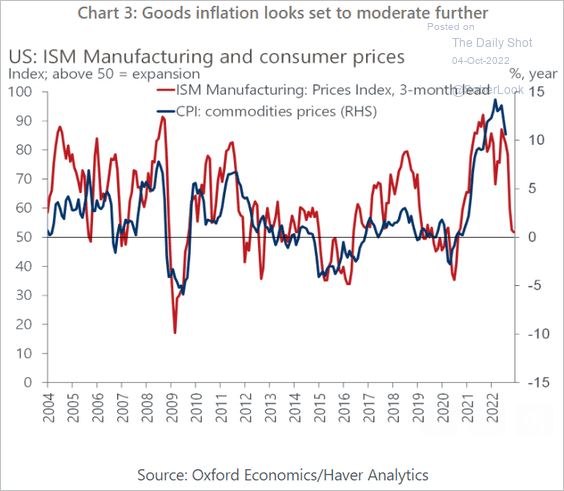 Source: Oxford Economics
Source: Oxford Economics
• The combination of faster supplier deliveries and shrinking order backlogs points to tighter corporate margins and lower PPI.
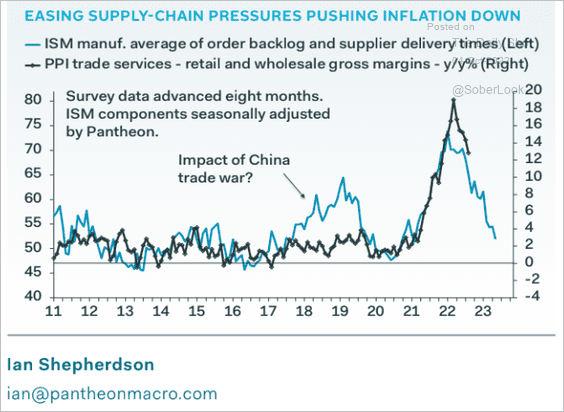 Source: Pantheon Macroeconomics
Source: Pantheon Macroeconomics
• The stock market suggests that we will see further declines in the ISM Manufacturing PMI. Here is the ratio of cyclical to defensive sectors vs. the ISM PMI.
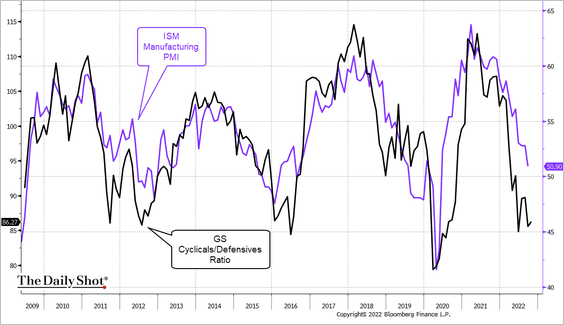
——————–
2. Treasury yields are moving lower.
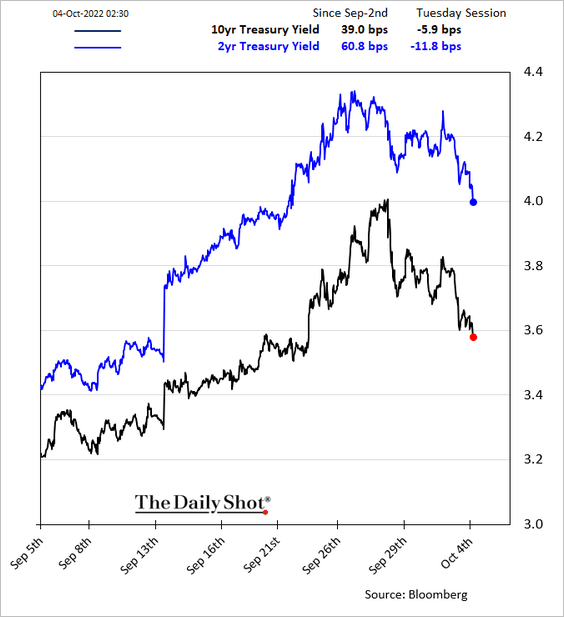
3. Construction spending declined again in August …
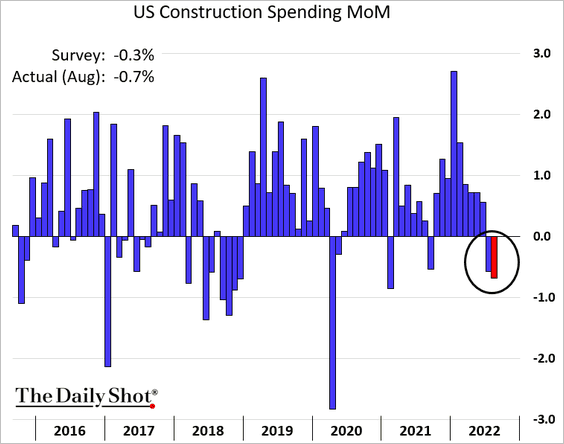
… driven by single-family housing (2 charts).
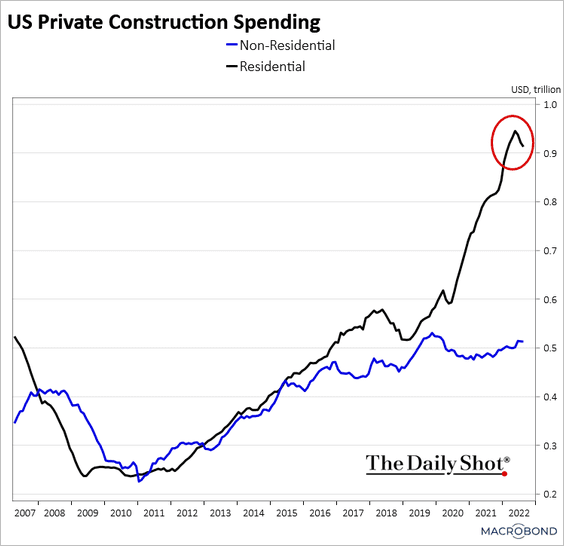 Source: Chart and data provided by Macrobond
Source: Chart and data provided by Macrobond
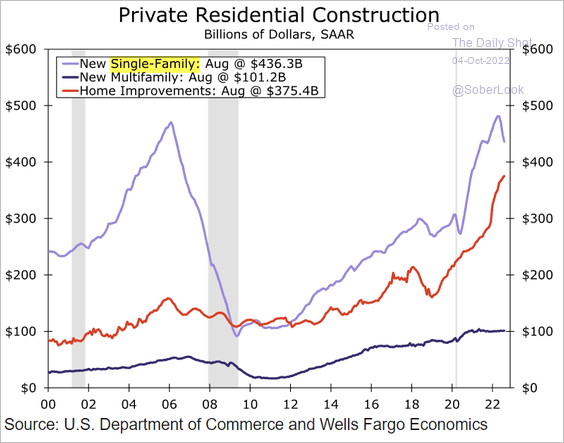 Source: Wells Fargo Securities
Source: Wells Fargo Securities
——————–
4. Auto sales edged higher in September.
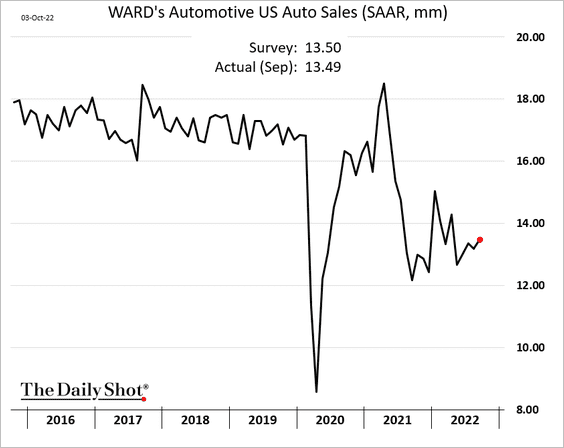
GM sales picked up in Q3.
 Source: CNBC Read full article
Source: CNBC Read full article
——————–
5. Job postings on Indeed continue to drift lower, but this rate of decline is not fast enough for the Fed. The goal is to get job openings to pre-COVID levels.
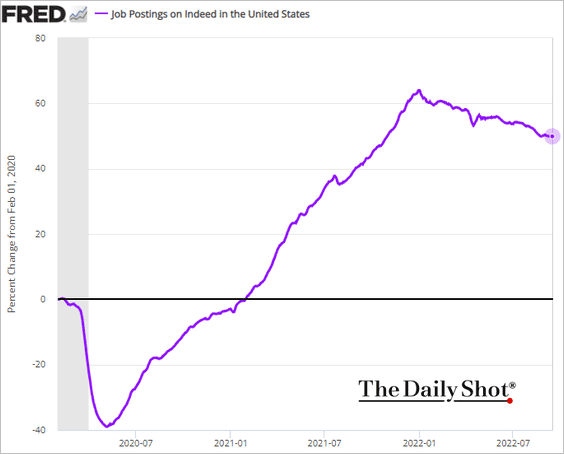
The decline in high-income postings has accelerated.
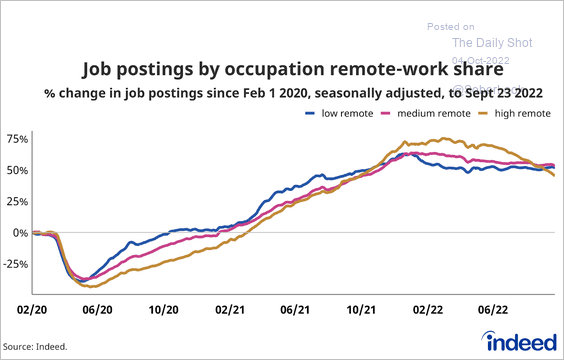 Source: @indeed
Source: @indeed
——————–
6. What are the drivers of tighter financial conditions?
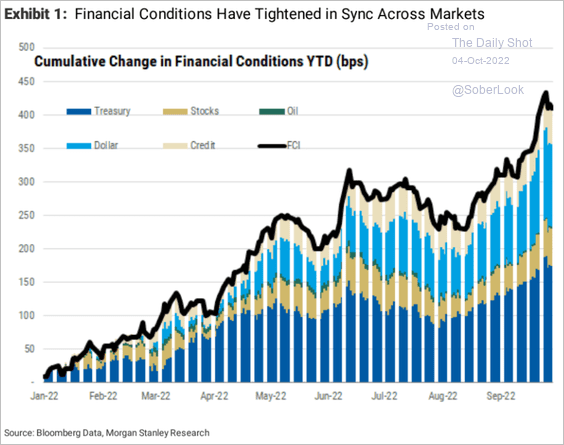 Source: Morgan Stanley Research
Source: Morgan Stanley Research
Will this tightening be enough to tip the economy into a recession? Here is a model from Morgan Stanley.
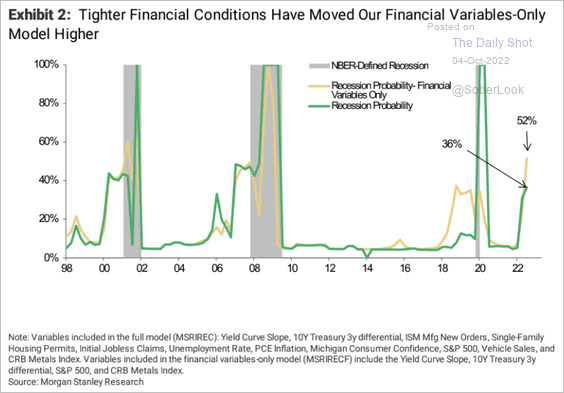 Source: Morgan Stanley Research
Source: Morgan Stanley Research
Back to Index
Canada
1. Consumer confidence remains depressed.
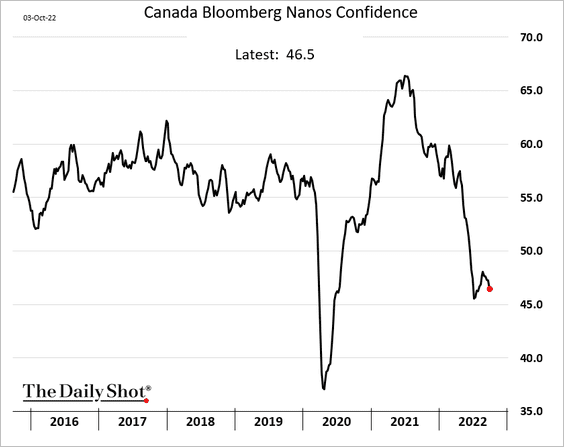
2. Job postings on Indeed continue to trend lower.
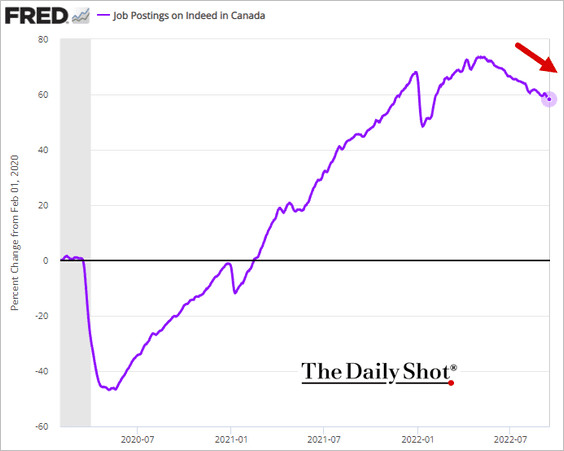
3. The PMI report shows no growth in factory activity.
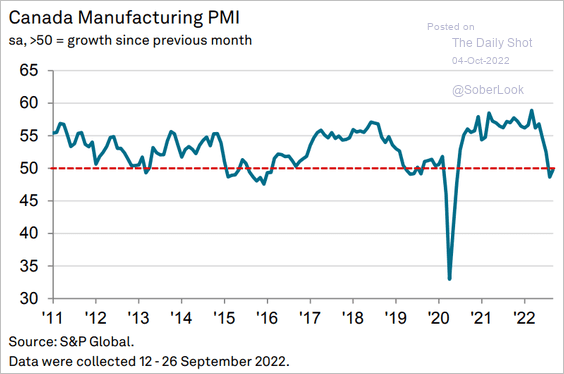 Source: S&P Global PMI
Source: S&P Global PMI
4. Canada’s pandemic-era slump in services spending has been deeper than in the US.
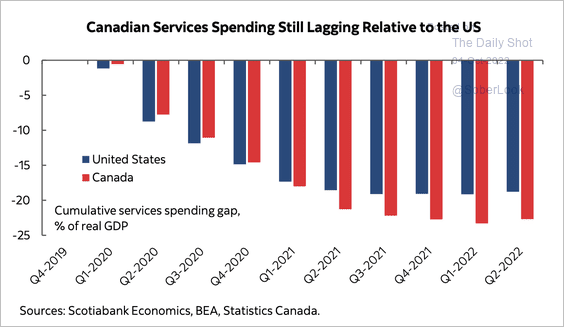 Source: Marc Ercolao; Scotiabank Economics
Source: Marc Ercolao; Scotiabank Economics
Back to Index
The United Kingdom
1. The volatility in long-term gilts has been extreme.
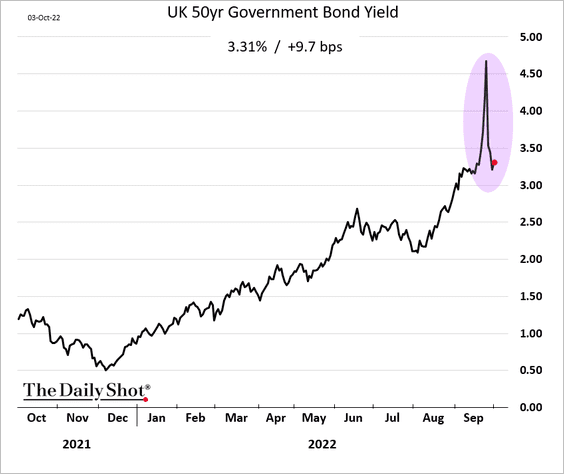
2. Here is a look at government spending and revenue throughout history.
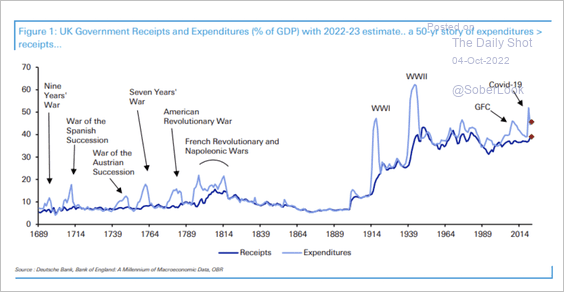 Source: Deutsche Bank Research
Source: Deutsche Bank Research
Back to Index
The Eurozone
1. The September manufacturing PMI report points to a recession in the Eurozone …
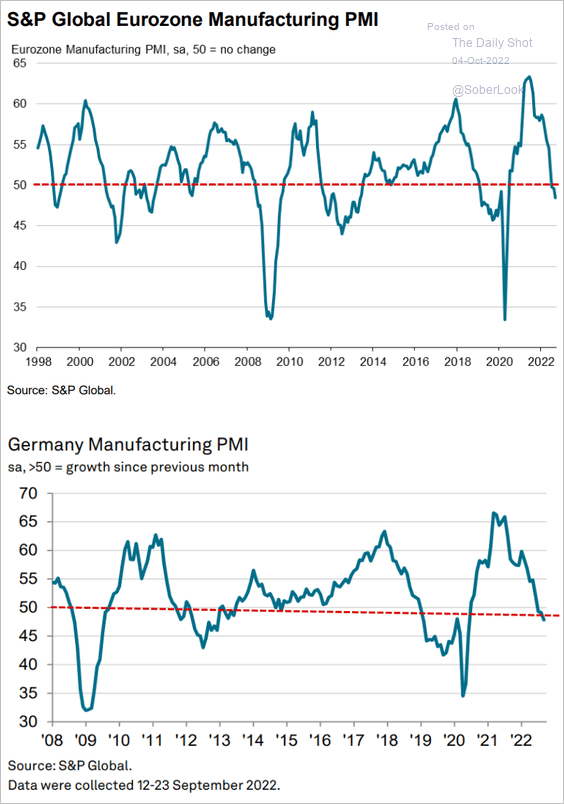 Source: S&P Global PMI
Source: S&P Global PMI
… as manufacturing orders slump.
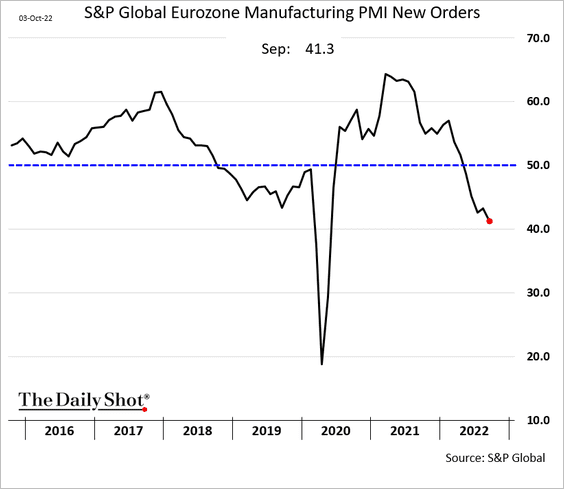
2. Energy-intensive sectors are in trouble.
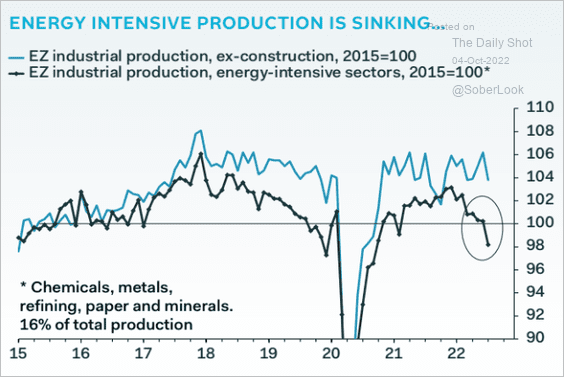 Source: Pantheon Macroeconomics
Source: Pantheon Macroeconomics
3. An inflection point in export order growth could eventually signal a rebound in EUR/USD.
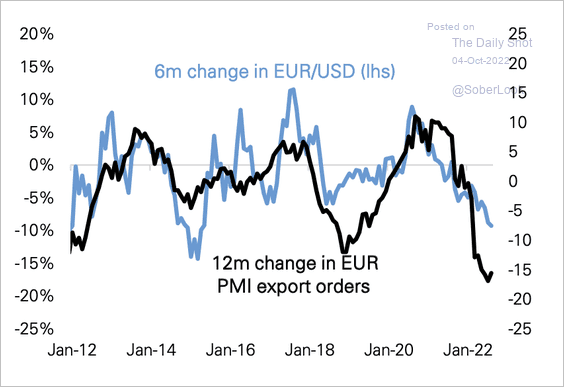 Source: Deutsche Bank Research
Source: Deutsche Bank Research
Back to Index
Europe
1. The Swiss central bank tightened monetary policy by sharply reducing liquidity last month.
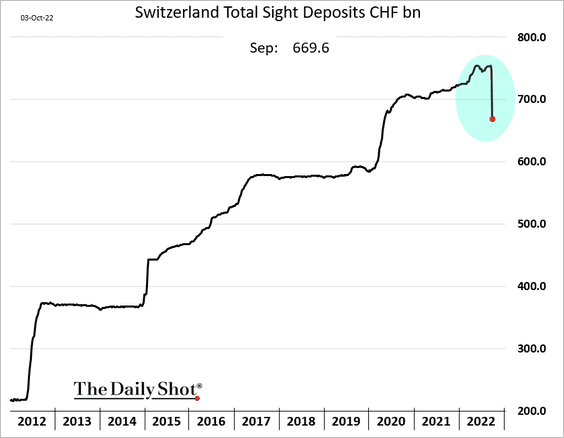
 Source: Reuters Read full article
Source: Reuters Read full article
——————–
2. This chart shows natural gas consumption in the EU by sector.
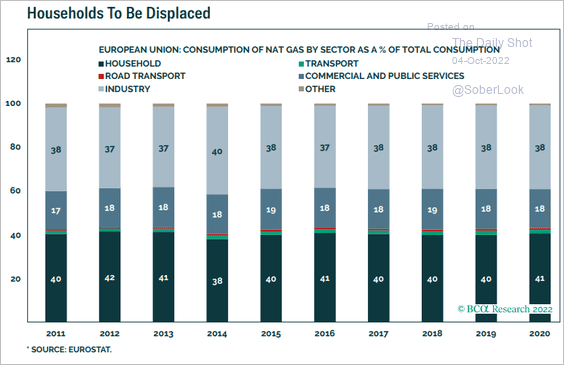 Source: BCA Research
Source: BCA Research
3. Czech Republic’s manufacturing sector is in a recession.
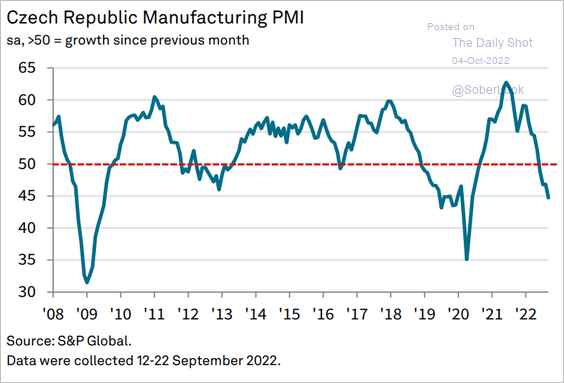 Source: S&P Global PMI
Source: S&P Global PMI
4. The spread between PMI indices of orders and inventories points to further economic pain in Europe.
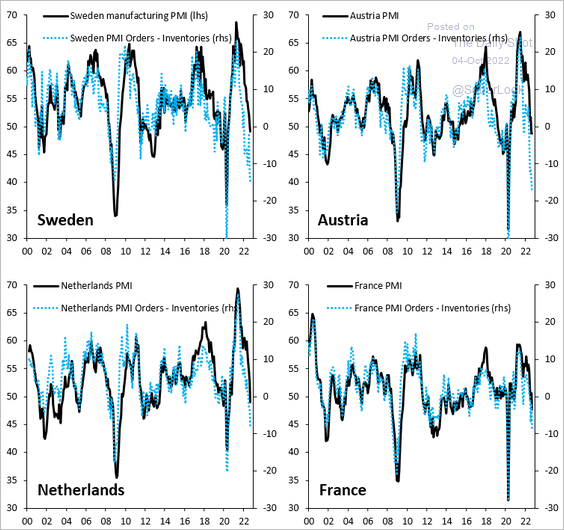 Source: @RobinBrooksIIF
Source: @RobinBrooksIIF
Back to Index
Japan
1. The Tokyo core CPI continued to climb in September.
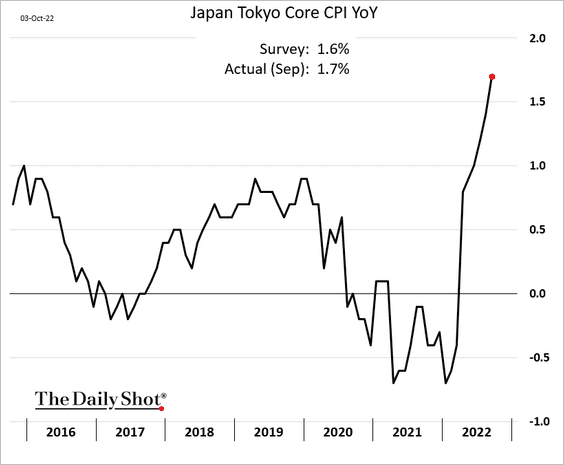
At the national level, inflation still lags behind peers markedly.
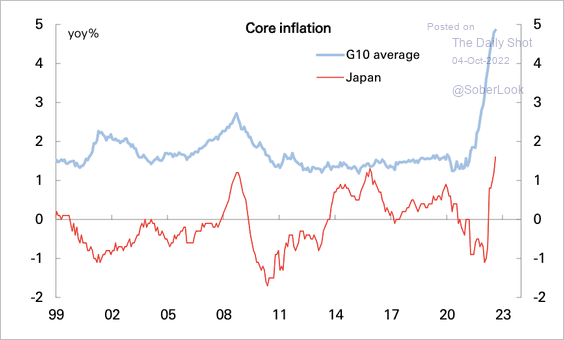 Source: Deutsche Bank Research
Source: Deutsche Bank Research
——————–
2. The BoJ has been conducting “stealth” tightening as the monetary base declines sharply.
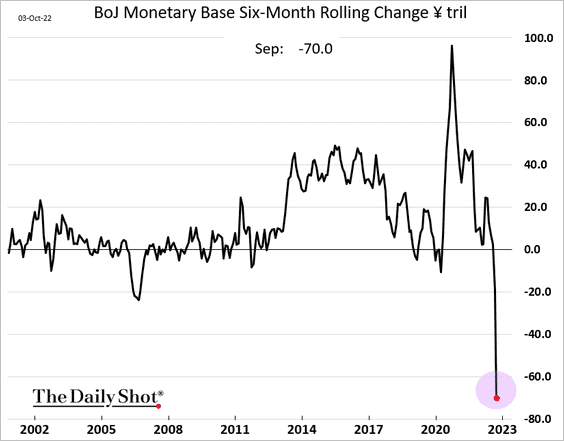
Back to Index
Asia – Pacific
1. Let’s begin with Australia.
• The RBA surprised the markets with a lower-than-expected rate hike (25 bps rather than 50 bps).
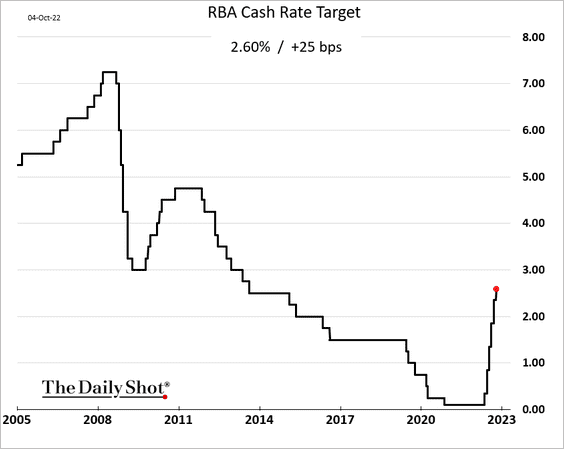
The dovish shift sent the Aussie dollar lower, …
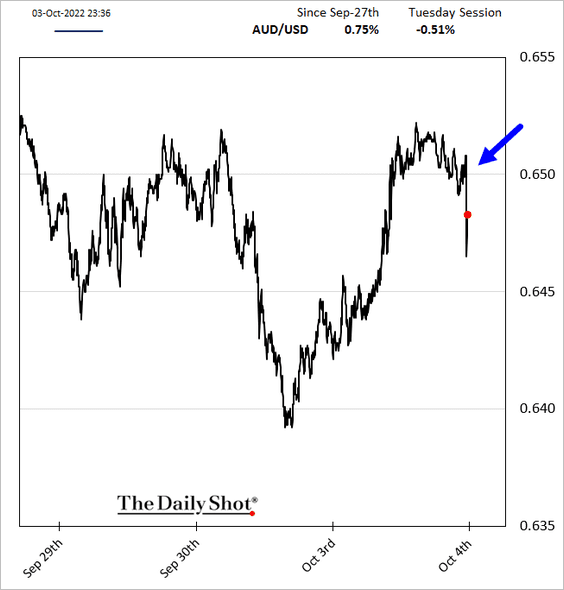
… while bonds rallied.

• Mortgage approvals were down again in August.
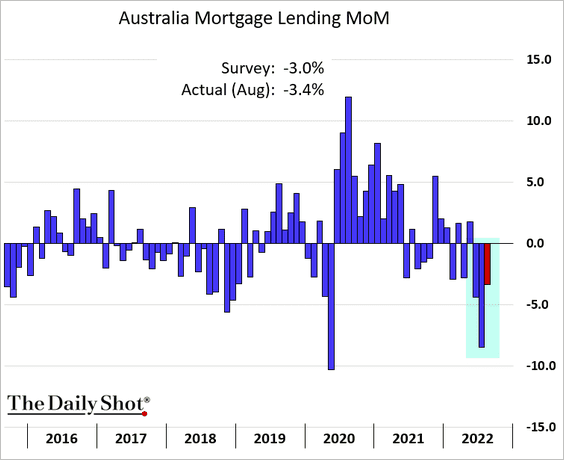
• Building approvals rebounded.
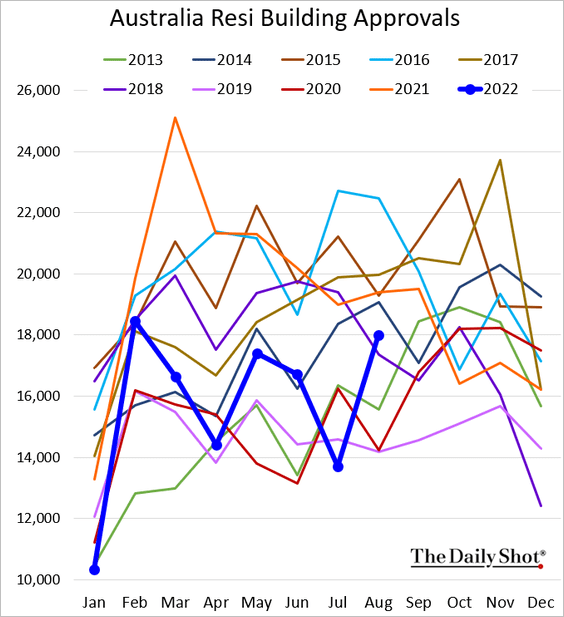
• The labor market remains tight.
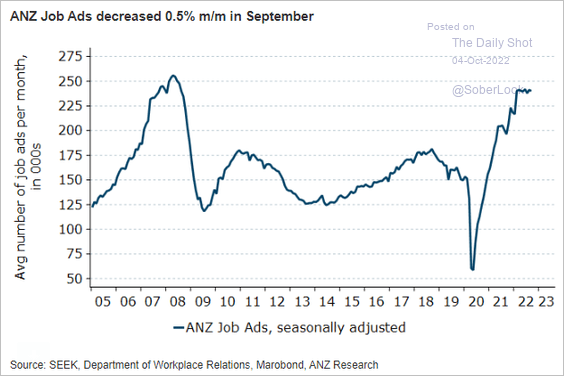 Source: @ANZ_Research
Source: @ANZ_Research
——————–
2. Singapore appears to be entering a recession.
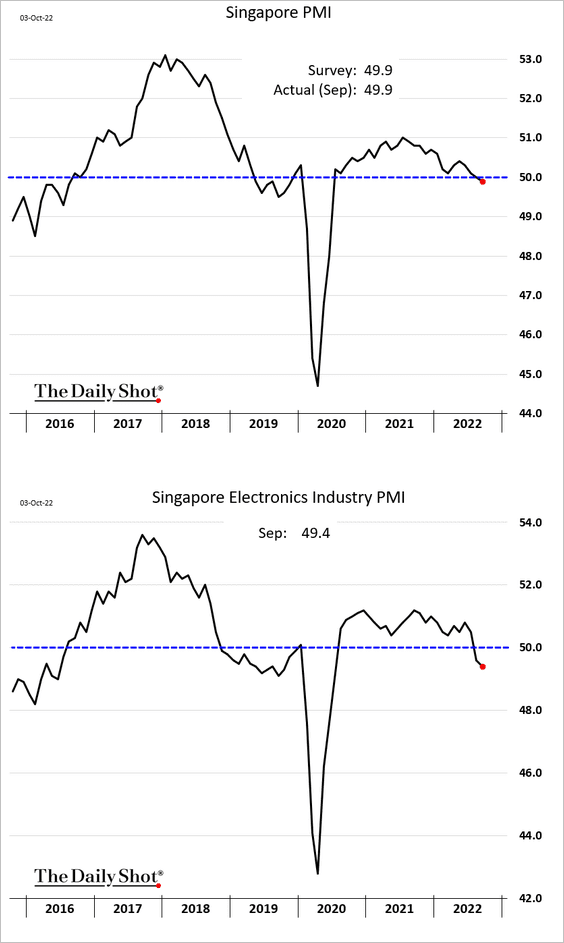
3. South Korea’s manufacturing contraction has accelerated.
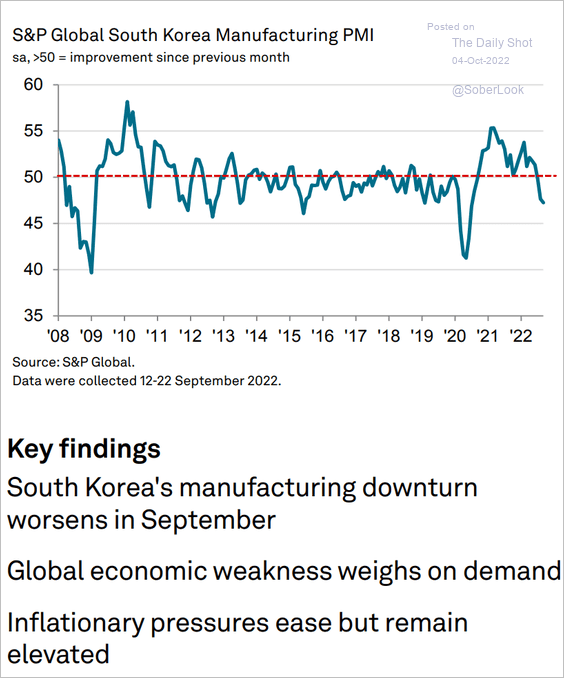 Source: S&P Global PMI
Source: S&P Global PMI
Back to Index
Emerging Markets
1. Let’s begin with Brazil.
• The unemployment rate keeps moving lower.
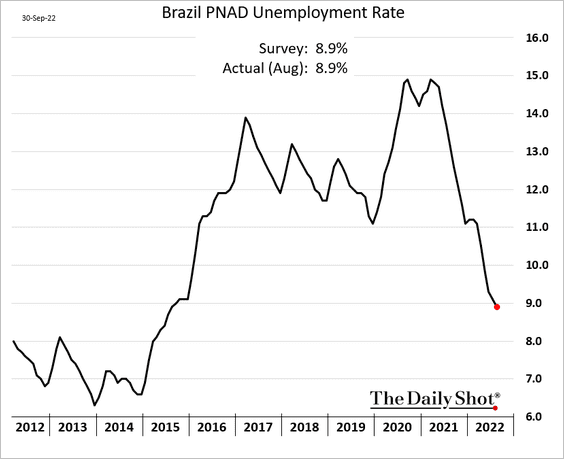
• Growth in factory activity has slowed.
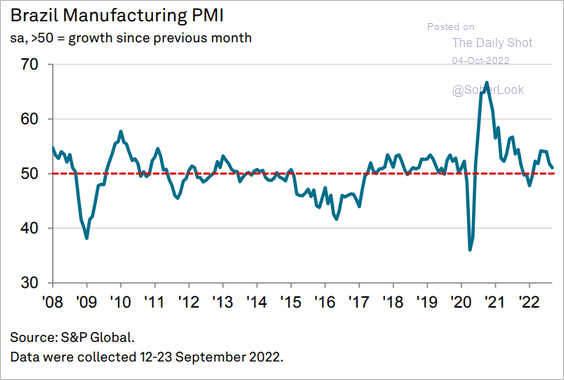 Source: S&P Global PMI
Source: S&P Global PMI
• The debt-to-GDP ratio edged higher in August.
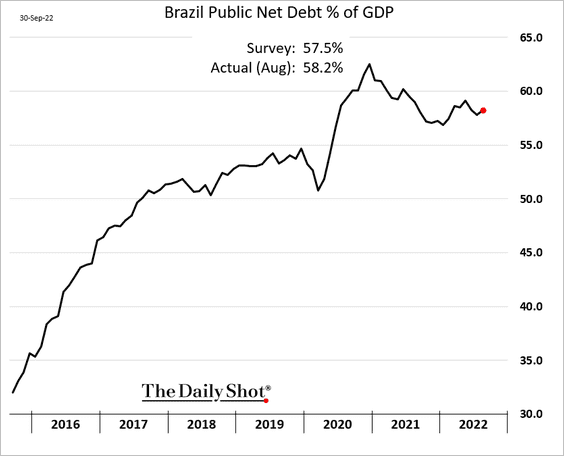
——————–
2. Next, we have some updates on Chile.
• Manufacturing output (some improvement from July):
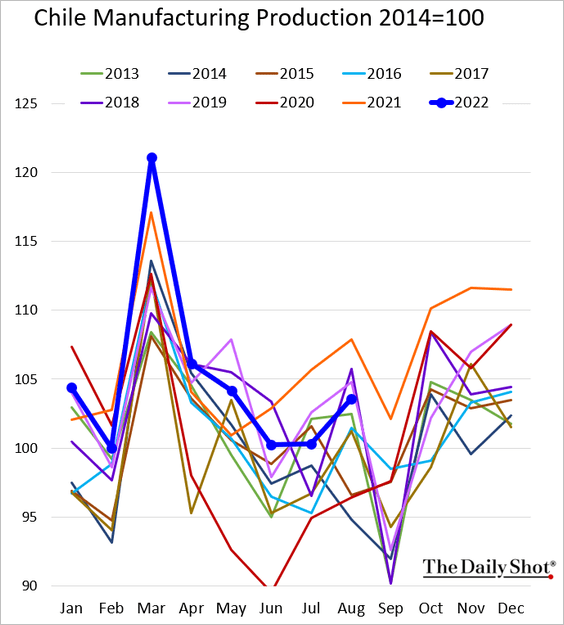
• Copper production (a disaster):
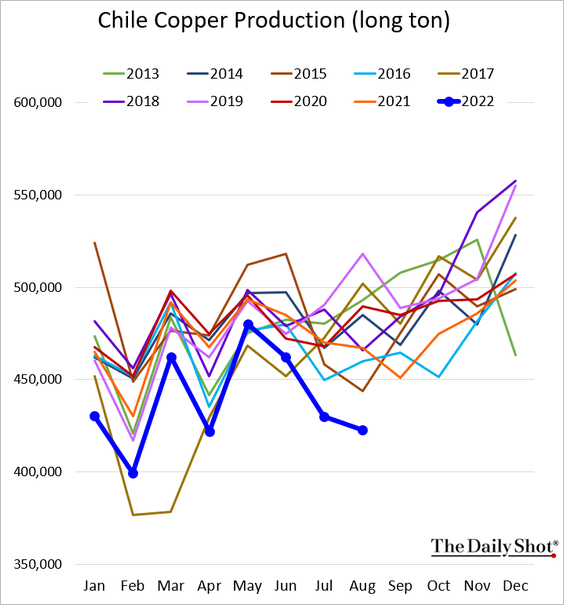
• Economic activity (higher in August):
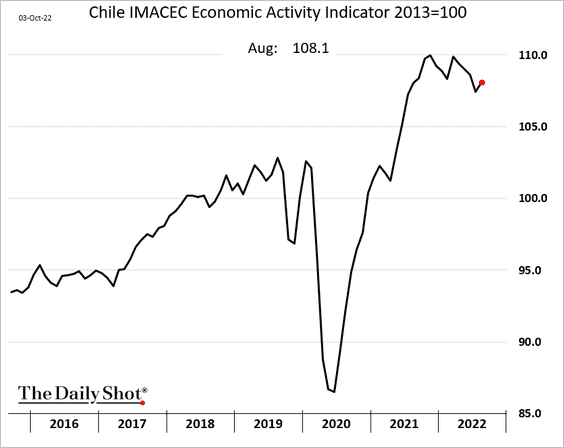
• Business confidence (an improvement in September):
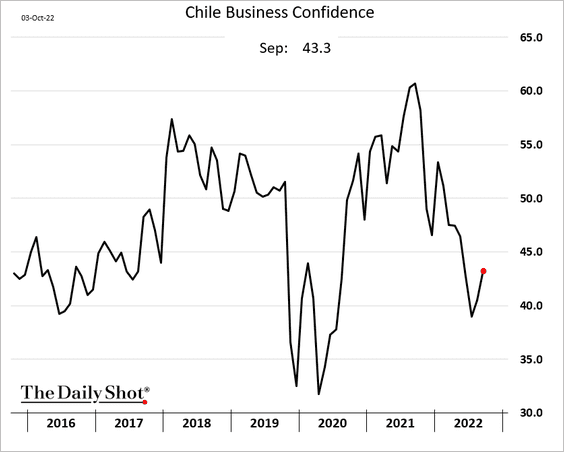
• Retail sales (below last year’s level but holding up):
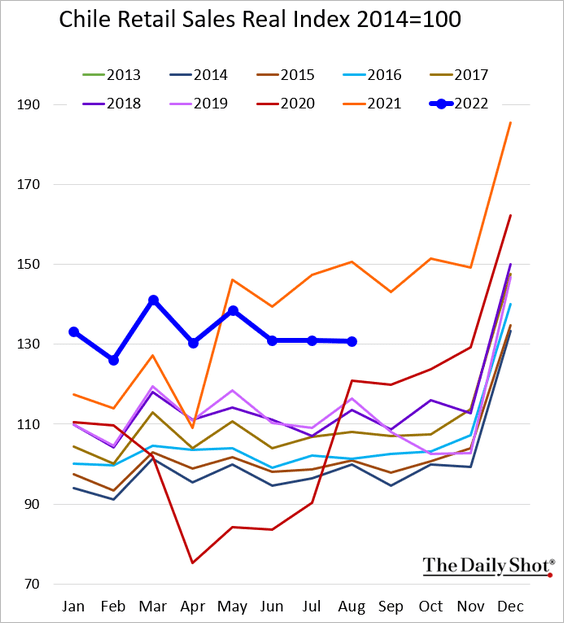
——————–
3. South Africa’s manufacturing is back in contraction territory.
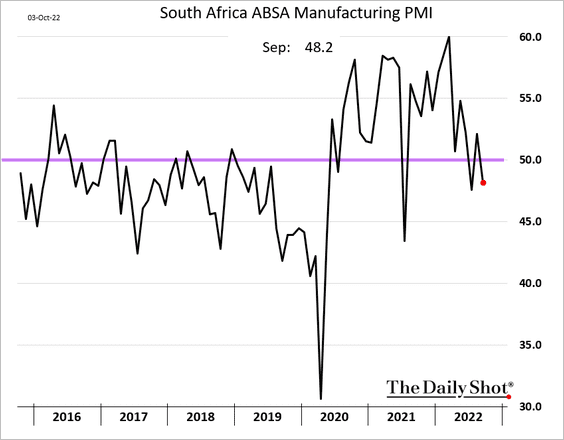
4. Turkey’s manufacturing decline accelerated last month.
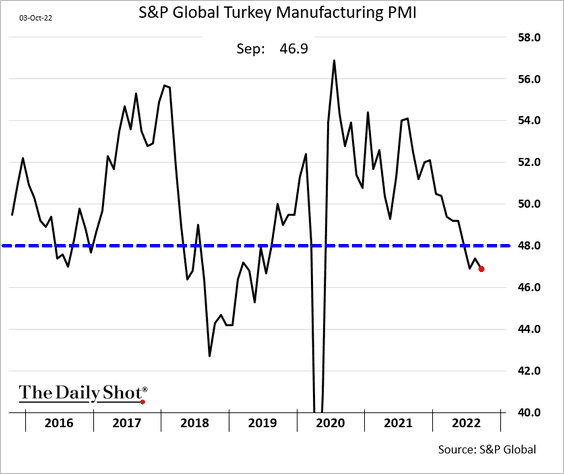
The nation’s core CPI is now above 68%. Let’s cut rates some more and see what happens.
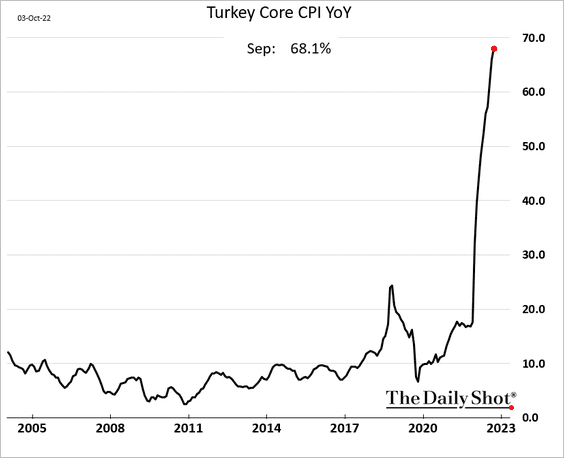
——————–
5. PMI data suggests that EM price pressures are receding.
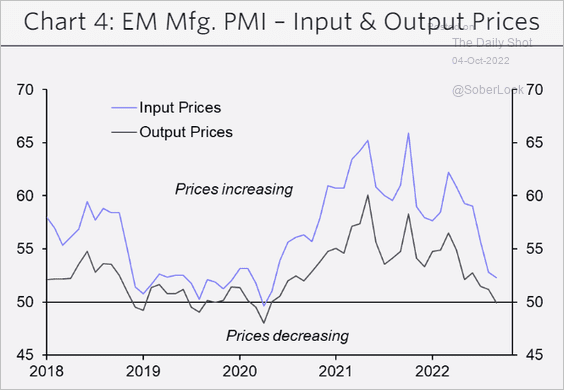 Source: Capital Economics
Source: Capital Economics
Back to Index
Cryptocurrency
1. Bitcoin has traded in a tight range this summer.
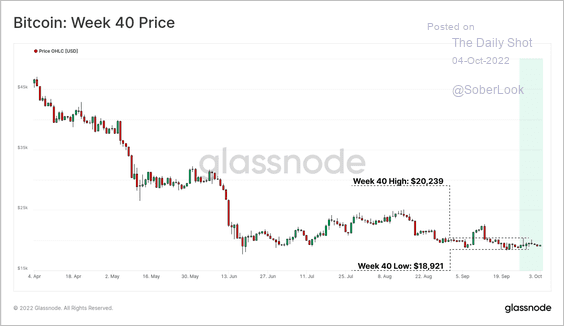 Source: Glassnode Read full article
Source: Glassnode Read full article
2. Bitcoin mining conditions are starting to improve as competition increases. So far, BTC’s price has not provided an incentive to miners this cycle.
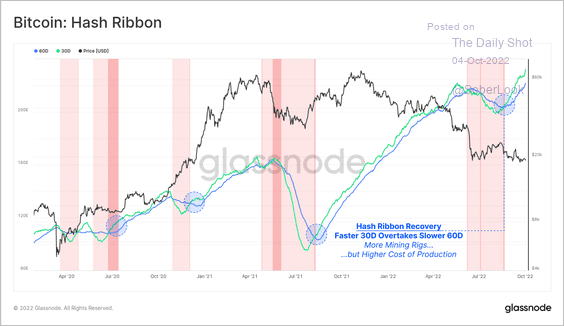 Source: Glassnode Read full article
Source: Glassnode Read full article
Here are some estimated production costs for BTC mining operations.
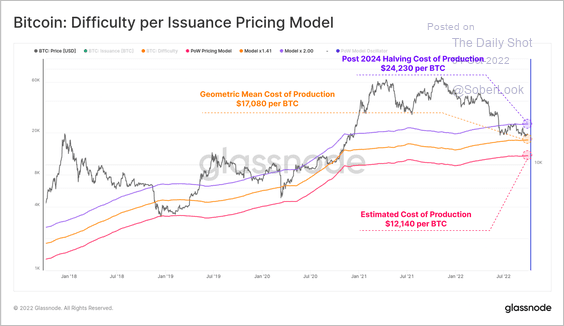 Source: Glassnode Read full article
Source: Glassnode Read full article
——————–
3. The Crypto Fear & Greed Index remains stuck in extreme fear mode.
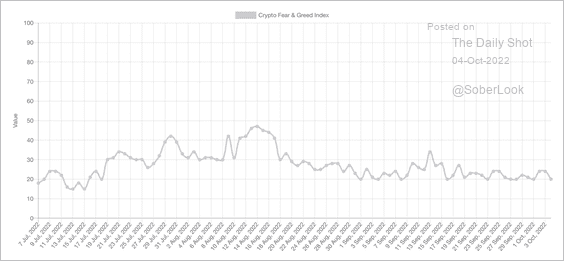 Source: Alternative.me
Source: Alternative.me
4. Crypto funds saw minor inflows last week led by Bitcoin and Ethereum-focused products.
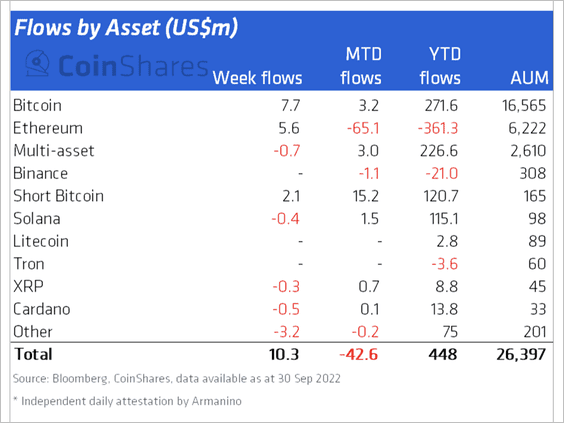 Source: CoinShares Read full article
Source: CoinShares Read full article
Switzerland and the US accounted for most fund inflows last week.
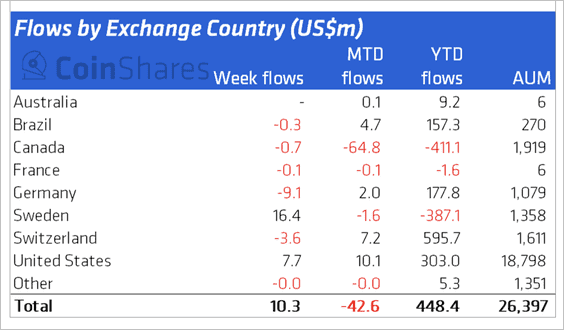 Source: CoinShares Read full article
Source: CoinShares Read full article
——————–
5. The Grayscale Bitcoin Trust’s (GBTC) discount to NAV reached an all-time low.
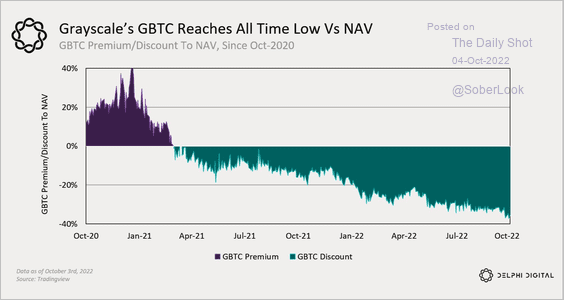 Source: @Delphi_Digital
Source: @Delphi_Digital
Back to Index
Commodities
1. Precious metals jumped on Monday as the dollar and Treasury yields moved lower. Silver surged (3 charts).
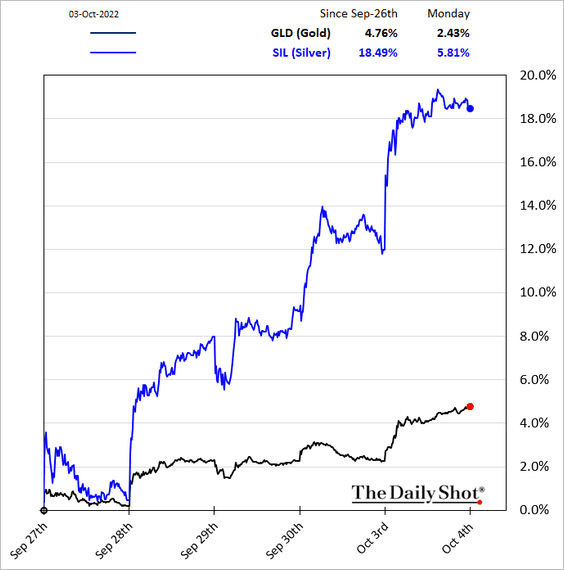
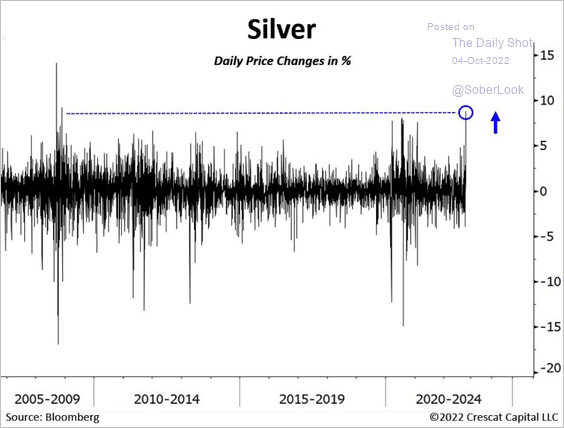 Source: @TaviCosta
Source: @TaviCosta
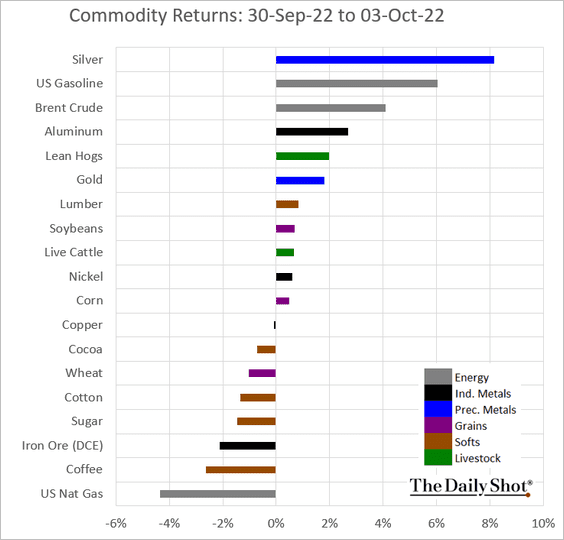
——————–
2. Softs are under pressure.
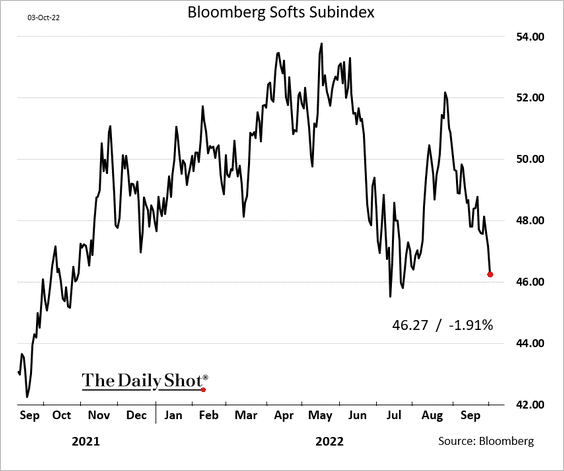
Here is sugar.
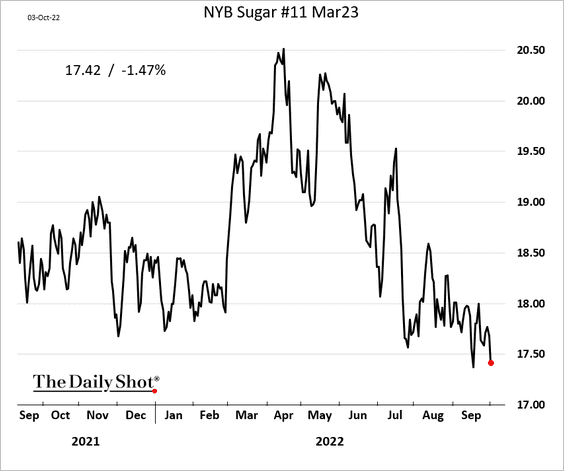
Back to Index
Energy
1. European natural gas prices keep falling despite Russia’s attempts to squeeze the market.
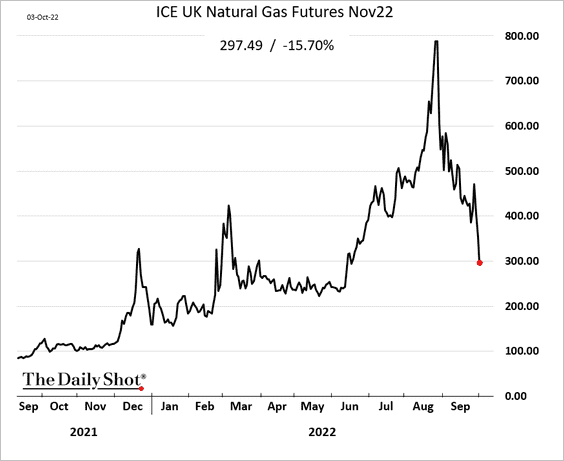
2. OPEC’s production has diverged sharply from targets.
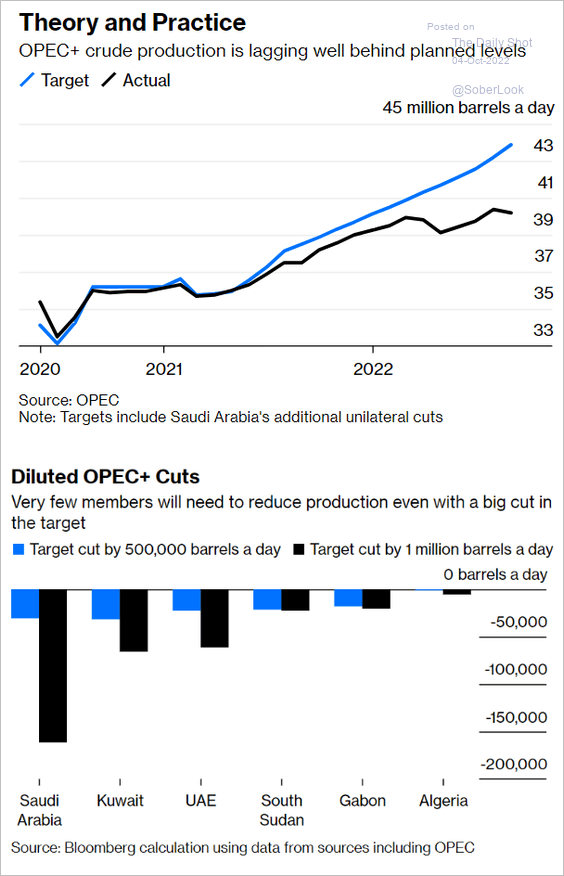 Source: Bloomberg Read full article
Source: Bloomberg Read full article
Back to Index
Equities
1. Stocks jumped as the dollar and Treasury yields moved lower. Hedge funds and institutions are short or massively underinvested.
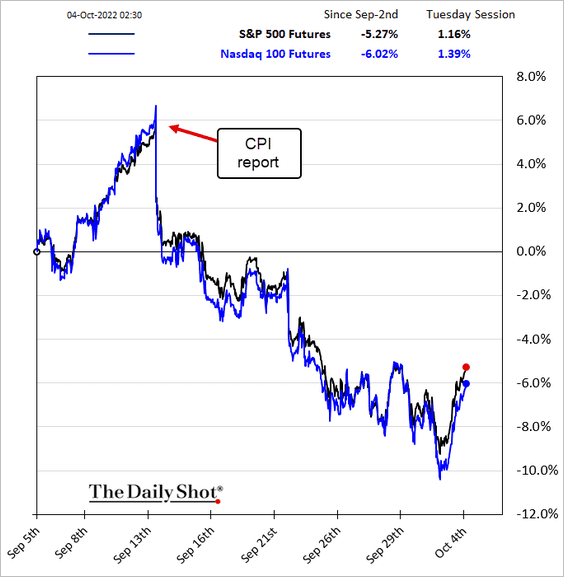
The energy sector outperformed on Monday.
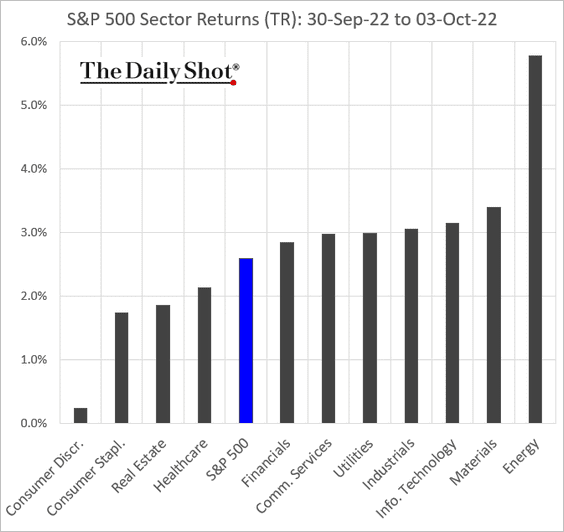
——————–
2. The S&P 500 held support at the 200-week moving average.
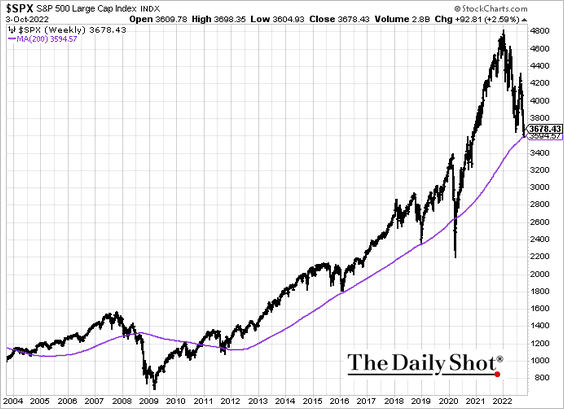
3. The Russell 2000 (IWM) has been testing support.
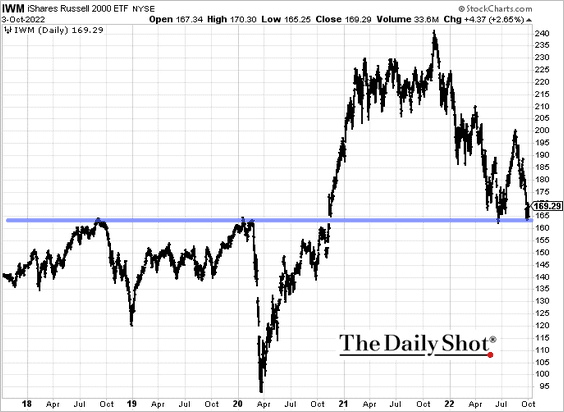
4. Last week, the percent of NYSE Composite stocks above their 200-day moving average reached the lowest level since the 2020 pandemic crash.
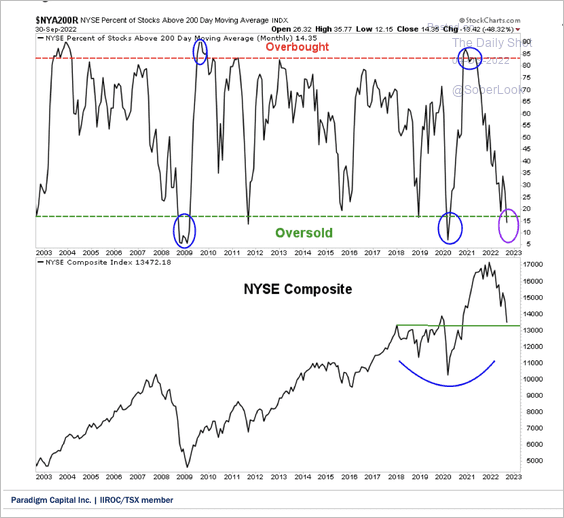 Source: Aazan Habib, Paradigm Capital
Source: Aazan Habib, Paradigm Capital
5. We’ve had a lot of risk-off days this year.
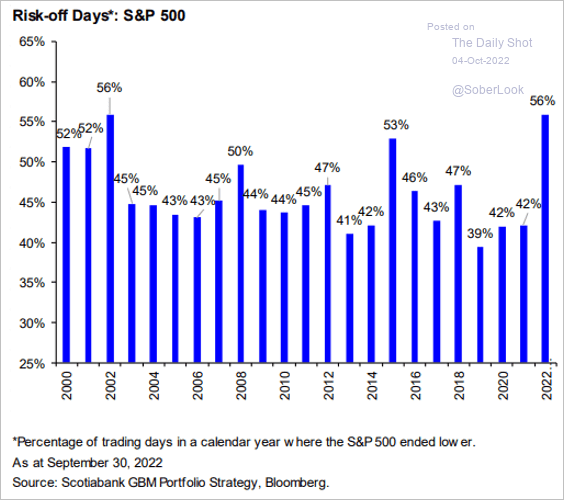 Source: Hugo Ste-Marie, Portfolio & Quantitative Strategy Global Equity Research, Scotia Capital
Source: Hugo Ste-Marie, Portfolio & Quantitative Strategy Global Equity Research, Scotia Capital
6. The S&P 500 2023 earnings estimates continue to decline.
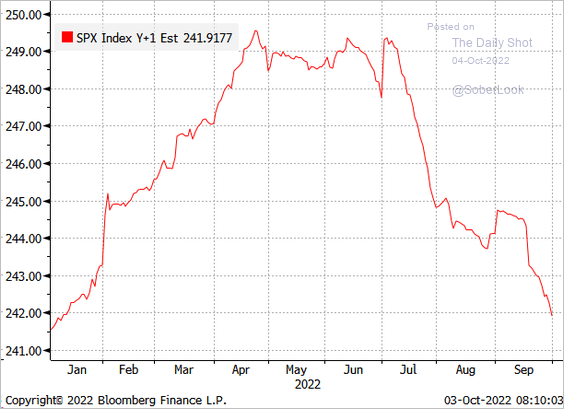 Source: @MichaelMOTTCM
Source: @MichaelMOTTCM
7. How did large-cap indices around the world perform last month?
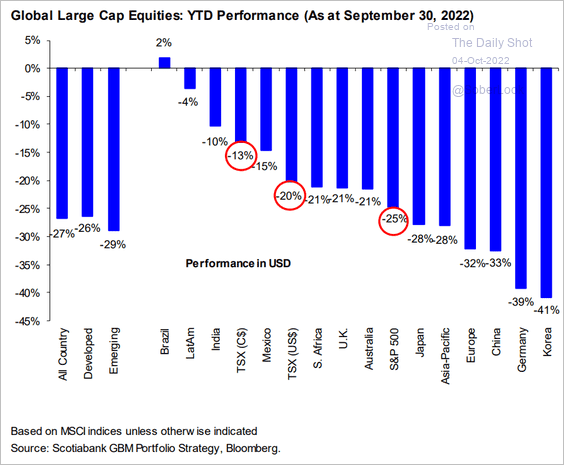 Source: Hugo Ste-Marie, Portfolio & Quantitative Strategy Global Equity Research, Scotia Capital
Source: Hugo Ste-Marie, Portfolio & Quantitative Strategy Global Equity Research, Scotia Capital
8. Dividend ETFs continue to see inflows.
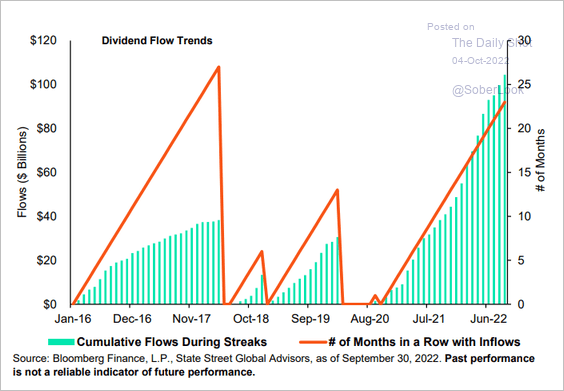 Source: SPDR Americas Research, @mattbartolini
Source: SPDR Americas Research, @mattbartolini
9. US households remain heavily exposed to stocks.
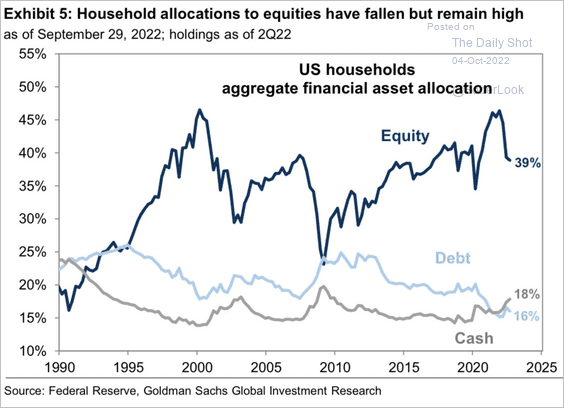 Source: Goldman Sachs; @carlquintanilla
Source: Goldman Sachs; @carlquintanilla
Back to Index
Credit
Increased market volatility suggests that corporate bond spreads should be wider.
• Investment grade:
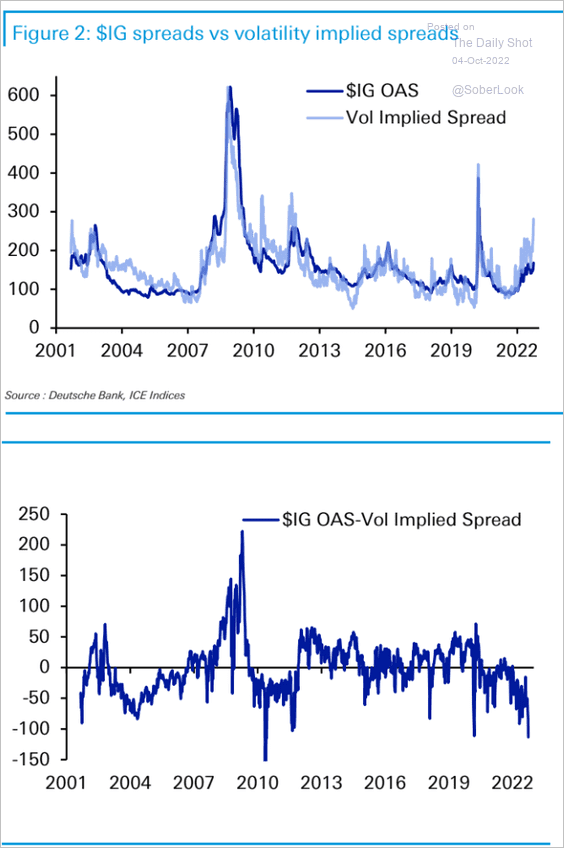 Source: Deutsche Bank Research
Source: Deutsche Bank Research
• High yield:
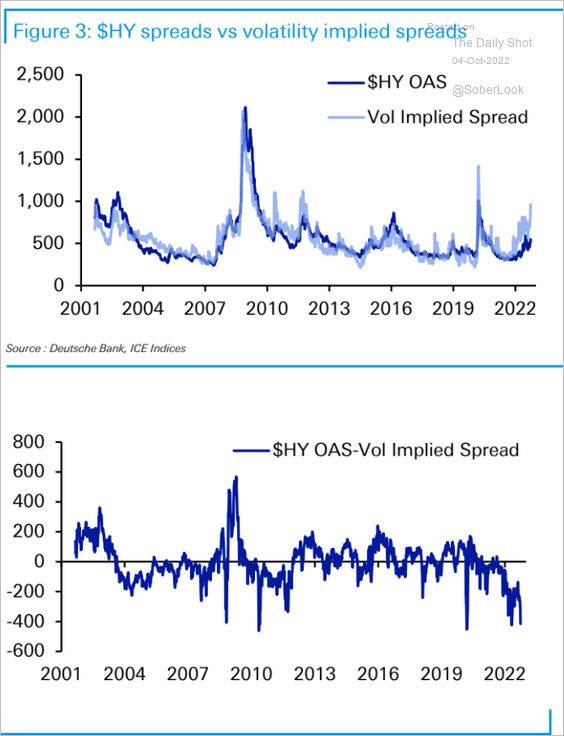 Source: Deutsche Bank Research
Source: Deutsche Bank Research
Back to Index
Rates
1. Flows into short-term Treasury funds surged in recent weeks.
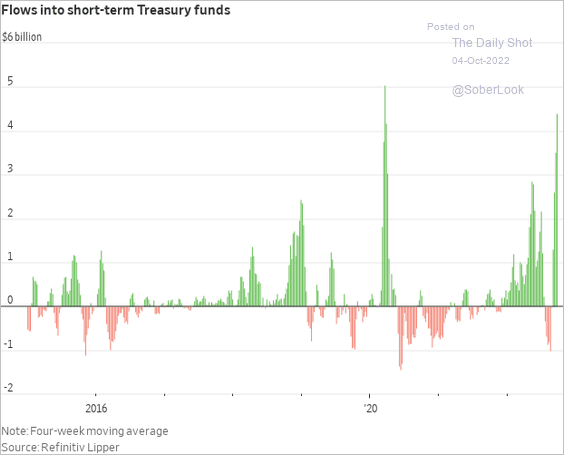 Source: @WSJ Read full article
Source: @WSJ Read full article
Investment fund demand for short and intermediate-term Treasuries at auction rose to new highs this year.
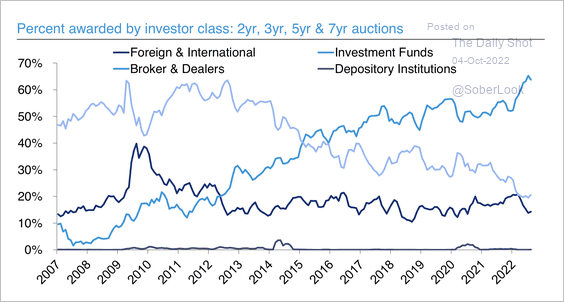 Source: Deutsche Bank Research
Source: Deutsche Bank Research
——————–
2. The fed funds rate is expected to peak at the end of 2023, according to Alpine Macro.
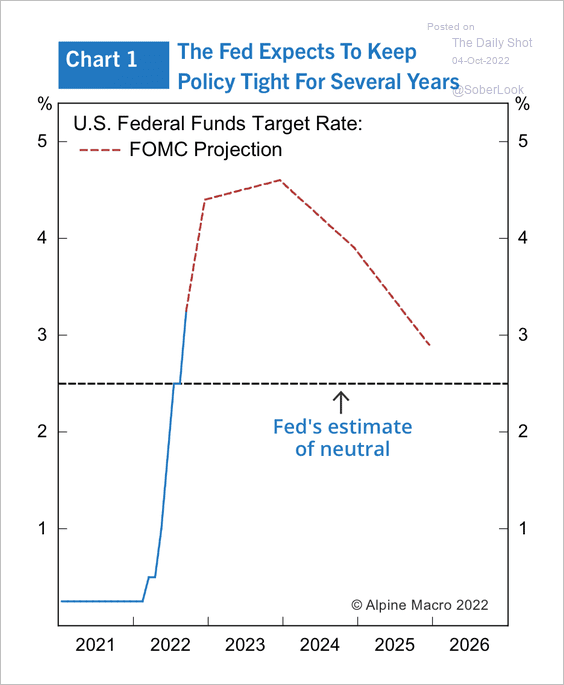 Source: Alpine Macro
Source: Alpine Macro
Back to Index
Global Developments
1. Global manufacturing growth has stalled.
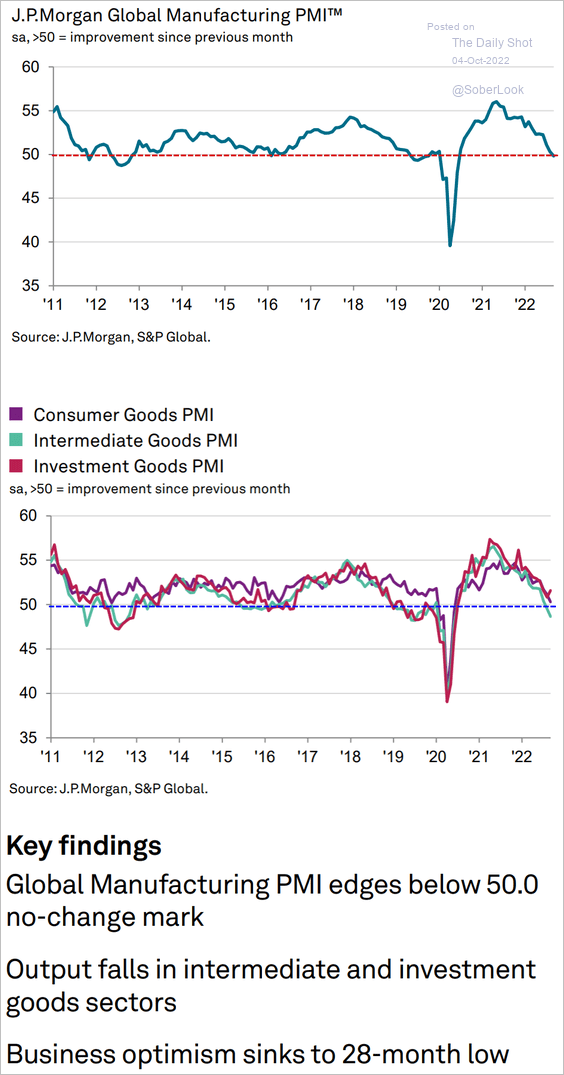 Source: S&P Global PMI
Source: S&P Global PMI
Here are the PMI indicators by country (PMI < 50 means contraction).
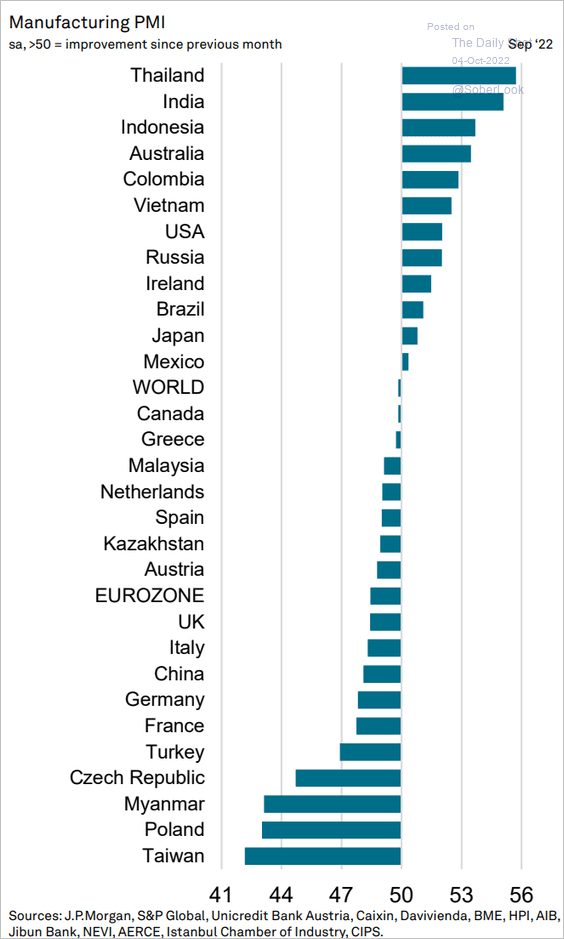 Source: S&P Global PMI
Source: S&P Global PMI
——————–
2. This chart shows the percentage of funds that saw inflows in September.
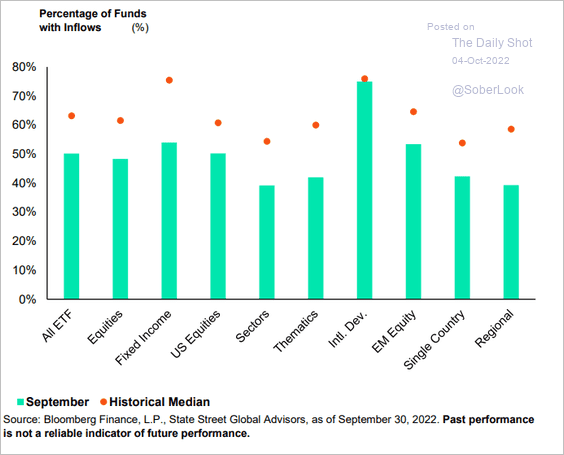 Source: SPDR Americas Research, @mattbartolini
Source: SPDR Americas Research, @mattbartolini
3. In previous recessions, the low in equities occurred alongside a peak in the dollar.
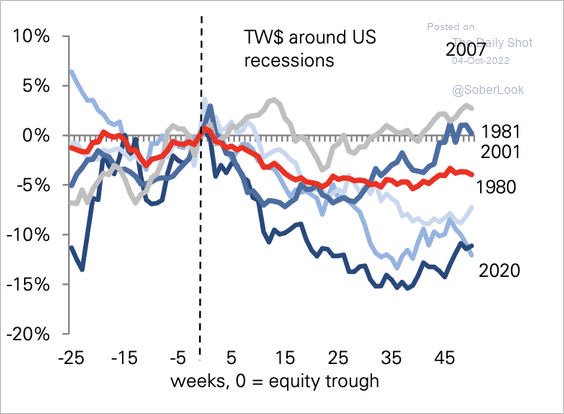 Source: Deutsche Bank Research
Source: Deutsche Bank Research
4. Nominal sovereign bond yields remained well below nominal GDP growth during the post-WWII deleveraging period, and debt funding is still relatively cheap today. Deutsche Bank expects yields to move closer to parity with GDP next year.
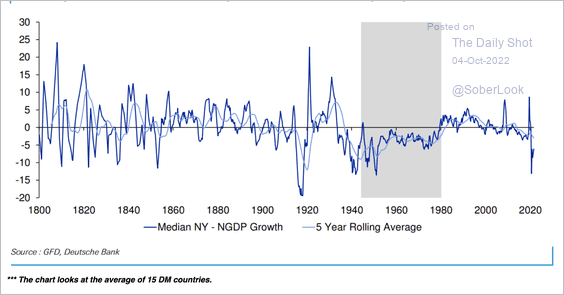 Source: Deutsche Bank Research
Source: Deutsche Bank Research
5. Government bonds look attractive.
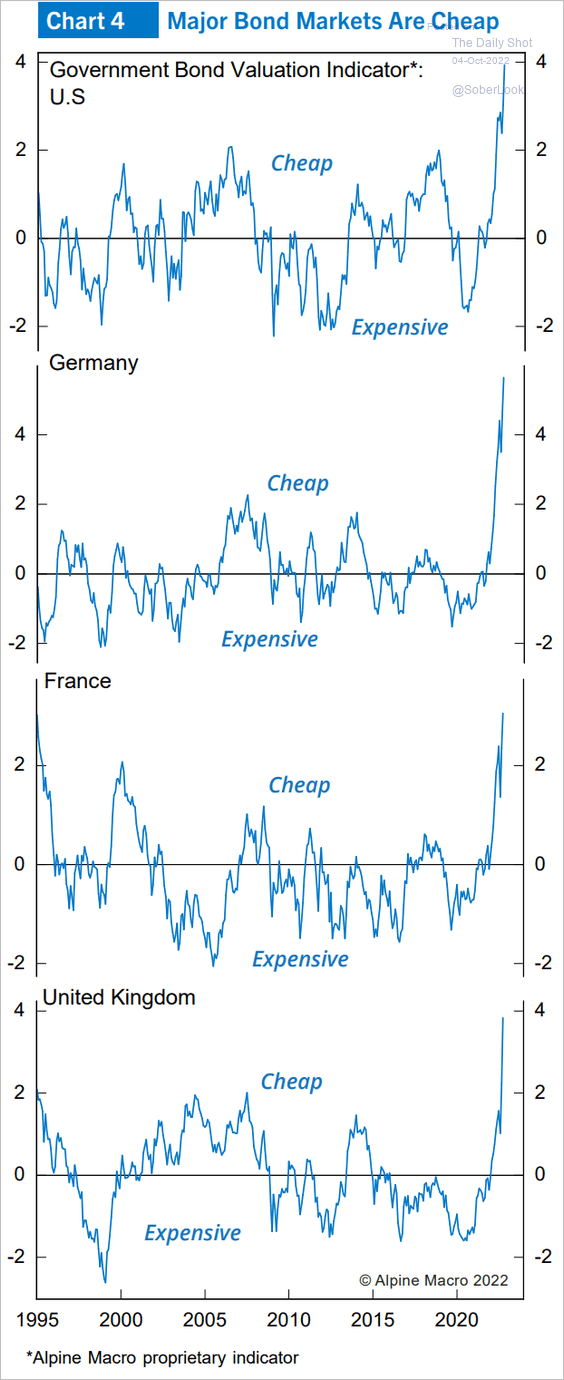 Source: Alpine Macro
Source: Alpine Macro
6. Will the cargo ship sector face overcapacity in the years ahead?
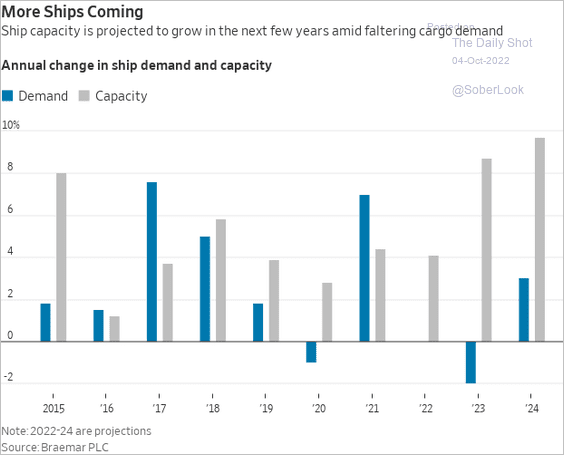 Source: @WSJ Read full article
Source: @WSJ Read full article
——————–
Food for Thought
1. Health spending per capita:
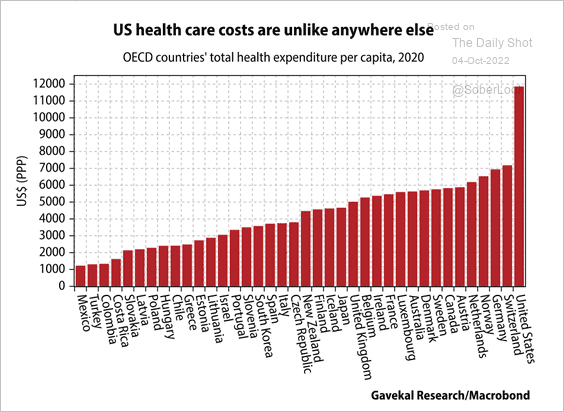 Source: Gavekal Research
Source: Gavekal Research
2. Getting the latest COVID booster:
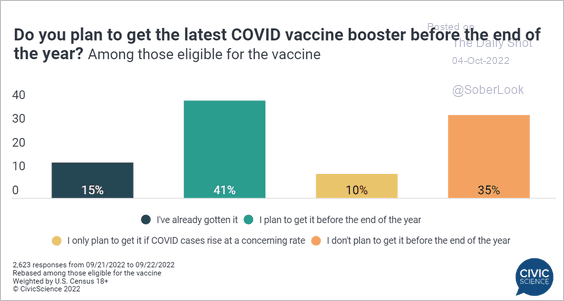 Source: @CivicScience Read full article
Source: @CivicScience Read full article
3. Corporate CFOs’ areas of focus:
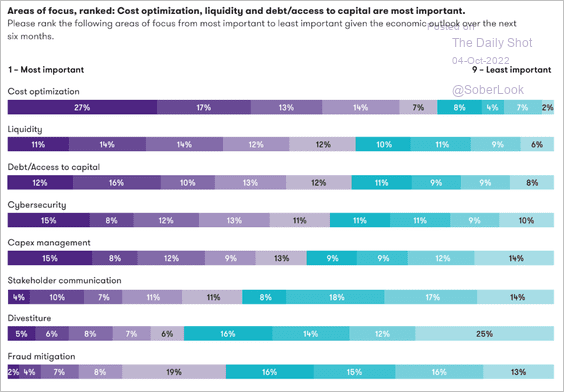 Source: Grant Thornton Read full article
Source: Grant Thornton Read full article
4. The EU’s aging population:
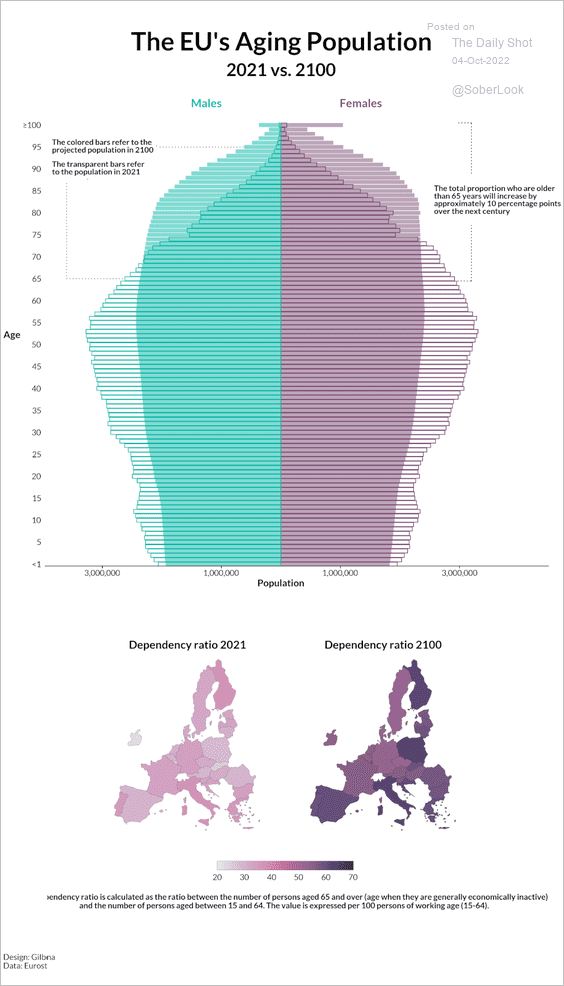 Source: Visual Capitalist Read full article
Source: Visual Capitalist Read full article
5. Increasing importance of natural gas in global energy consumption:
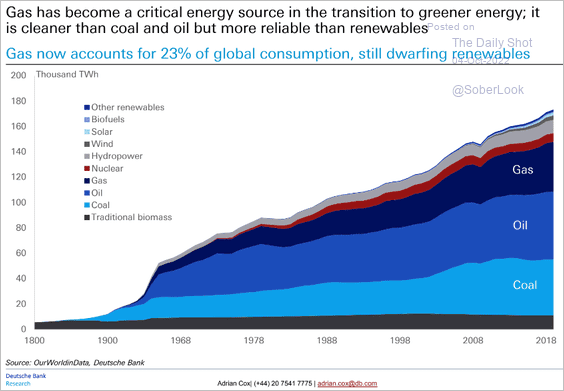 Source: Deutsche Bank Research
Source: Deutsche Bank Research
6. How Hispanic and Latino Americans describe their identity:
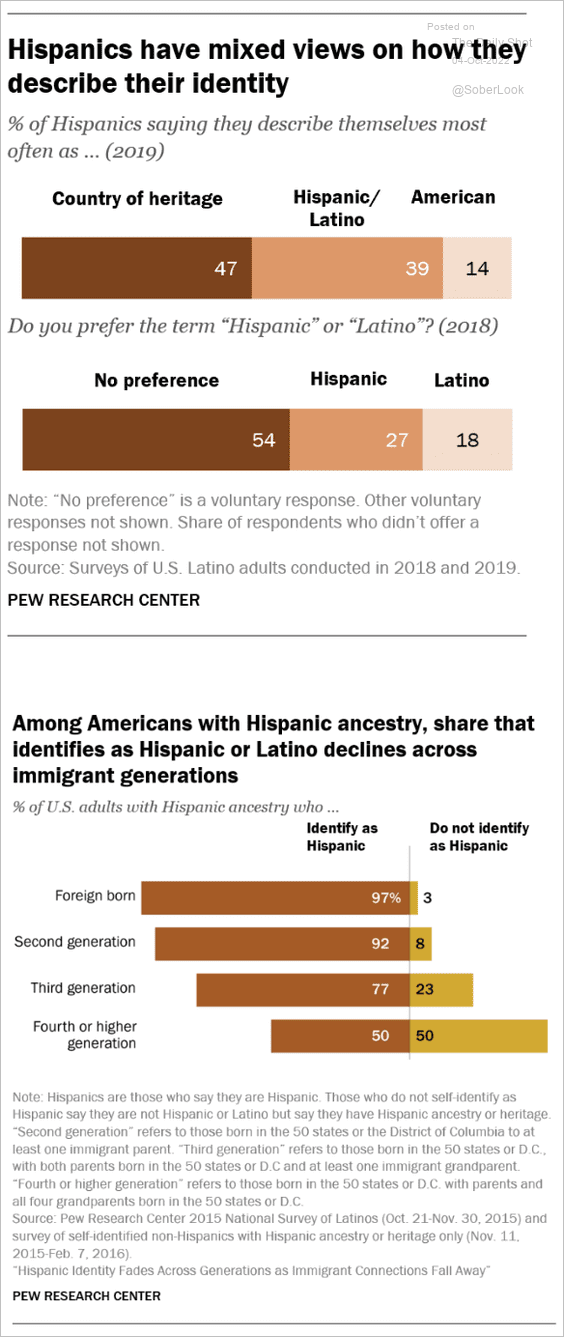 Source: Pew Research Center Read full article
Source: Pew Research Center Read full article
7. The best food cities:
 Source: @chartrdaily
Source: @chartrdaily
——————–
Back to Index
